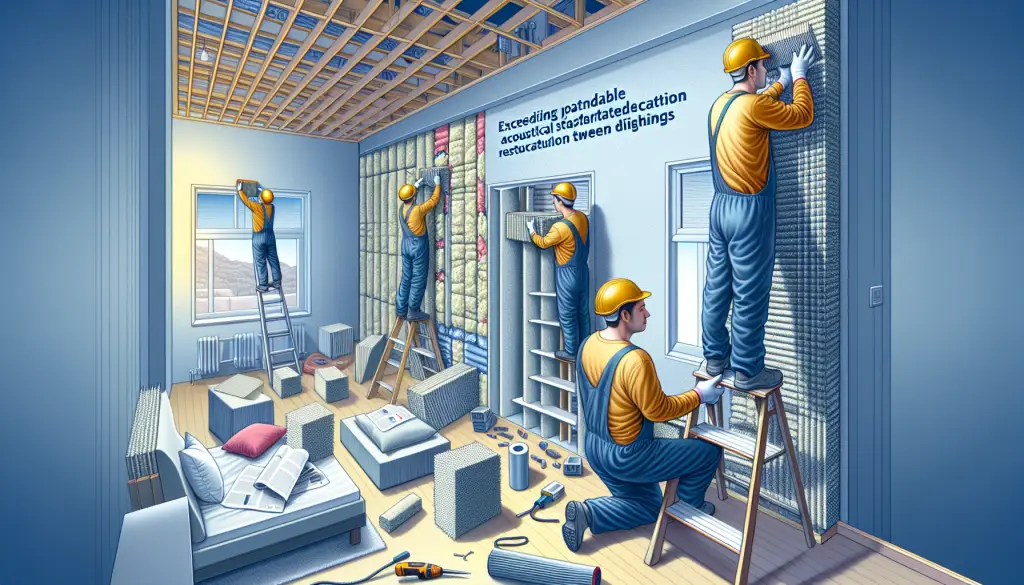Understanding Sound Insulation Requirements
When discussing sound insulation, it is essential to understand the minimum requirements and standards enforced in the industry. The Building Regulations Approved Document E sets forth the baseline criteria for sound insulation in residential buildings, ensuring that levels of airborne and impact noise are controlled effectively.
Airborne Noise
Airborne noise, such as voices, music, or TV sounds, is transmitted through open air and walls. Effective insulation is required to minimise the intrusion of such noises between dwellings.
Impact Noise
Impact noise, on the other hand, originates from physical interactions like footsteps and furniture movement. Enhancing sound insulation to mitigate these disturbances is crucial for maintaining peace and comfort within a home.
Why Sound Insulation Is Crucial
Implementing sound insulation in residential buildings does more than just comply with regulations; it also significantly enhances the quality of life for occupants.
User Comfort and Privacy
By reducing noise transmission, residents can enjoy a higher level of privacy and a more tranquil living environment, which is particularly beneficial in multi-family housing units.
Increased Property Value
Effective sound insulation can add significantly to a property’s market value by making it a more attractive investment for potential buyers or tenants.
Adherence to Standards
Meeting regulatory requirements protects against future legal complications and potential renovation costs associated with non-compliance.
Techniques for Optimising Sound Insulation
Several methods can be employed to optimise sound insulation in residential buildings, helping to both meet and exceed required standards.
Double Layered Walls
Constructing double-layered walls with air gaps in between can dramatically reduce noise transmission.
- Utilise resilient channels
- Incorporate mass-loaded vinyl
- Use high-density materials
Use of Acoustic Seals and Barriers
Acoustic seals and barriers are essential for sealing gaps and cracks where noise can easily propagate. They are particularly effective around doors, windows, and pipe penetrations.
Floating Floors and Ceilings
Installing floating floors and ceilings can help to insulate against impact noise. These systems typically involve:
- Using a damping compound
- Incorporating soundproof underlays
- Adding suspended ceilings
Innovative Sound Insulation Products
Advancements in technology have led to the development of highly effective sound insulation products. Ratio Seven offers a wide range of solutions designed to meet and exceed industry standards.
Acoustic Panels
Our acoustic panels can be easily installed in various parts of the building to absorb and dampen noise. They are perfect for both dedicated home theatres and everyday living spaces.
Insulated Drywall
Industry-grade insulated drywall provides a robust solution for enhancing sound insulation. It is both lightweight and easy to install, making it a practical choice for new builds and renovations.
Recommended Installation Practices
Proper installation is key to maximising the effectiveness of any sound insulation strategy.
Professional Consultation
Always consider consulting with professionals experienced in sound insulation installation. Expert advice ensures that all materials and techniques are applied correctly, optimising performance.
Regular Maintenance
Regularly inspect sound insulation systems to ensure they continue to perform effectively. Over time, materials can degrade or shift, reducing their efficiency.
Sound Insulation Testing
Sound insulation testing is an essential step in ensuring that the insulation measures in place meet both regulatory standards and the unique requirements of the building.
Pre-Completion Testing
Pre-completion testing should be conducted before the final stages of construction. This allows for any necessary adjustments and peace of mind that standards are met.
Post-Completion Testing
Post-completion testing ensures that all elements of the insulation have been correctly installed and are functioning as intended. It’s an assurance of sustained performance over time.
Sound Insulation Summary
In summary, effective sound insulation between dwellings is essential for regulatory compliance, occupant comfort, and property value. By employing a combination of techniques and high-quality products such as those offered by Ratio Seven, sound insulation in residential buildings can meet and exceed the minimum standards, ensuring a quieter, more comfortable living environment.

FAQs
What is the difference between airborne and impact noise?
Airborne noise refers to sound that travels through the air and into adjacent spaces, such as voices or music. Impact noise, on the other hand, is generated by direct physical contact, such as footsteps or the movement of furniture. Both types of noise can be mitigated with appropriate sound insulation measures.
How can I test the effectiveness of my sound insulation?
Sound insulation effectiveness can be tested through both pre-completion and post-completion testing methods. These tests help identify any gaps or weaknesses in your insulation strategy, allowing for timely adjustments to ensure compliance and optimal noise reduction.
Do I need a professional to install sound insulation?
While it is possible to install some sound insulation products yourself, professional installation ensures that all materials and methods are applied correctly. Using a professional can help maximise the effectiveness of your sound insulation strategy, providing peace of mind and long-term performance.




